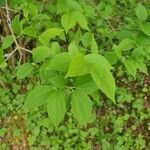Shrubs, 10–65 dm. Stems erect to ascending, green, older stems gray, glabrous or sparsely strigose or villous, especially at nodes; bark tight, not exfoliating or flaking, gray; branches erect; axillary buds hidden in pouches. Leaves: petiole 1–12(–20) mm; blade broadly lanceolate to broadly ovate, or narrowly to broadly elliptic, (3–)5–10(–16) × 1.6–7(–11) cm, base narrowly cuneate to rounded, margins entire or irregularly to regularly serrate, crenate, or dentate, plane, abaxial surface moderately to densely strigose or tomentose to villous, hairs twisted, main vein axils and main veins often more densely strigose-tomentose, adaxial surface glabrous or very sparsely strigose, especially near base and margins. Inflorescences usually cymose racemes or cymose panicles, sometimes flowers solitary, (1–)5–9-flowered, proximal 2 or 4 flowers often in axils of nearly normal to much reduced (bracteal) leaves. Pedicels 3–8 mm, glabrous or moderately strigose. Flowers: hypanthium sparsely to densely strigose or villous; sepals ovate, ovate-lanceolate, or triangular, 5–8 × 3–5 mm, apex acute to acuminate, abaxial surface moderately to densely strigose or villous, adaxial surface densely villous distally; petals white, oblong, obovate, or orbiculate, 12–21 × 8–12 mm; stamens 25–50; filaments distinct, 5–11 mm; anthers 1.5 × 1 mm; styles 4, connate proximally, cylindric, 6–10 mm, lobes 1.5–5 × 0.4–0.7 mm; stigmatic surfaces 1.5–4 mm. Capsules obconic to obovoid, 6–11 × 4–7 mm. Seeds caudate, 3–4 mm. 2n = 26.
More
Stiffly branched shrub 1–3 m; bark of young twigs gray, not exfoliating; lvs ovate-elliptic, 5–8 cm, acuminate, glabrous above, the lower surface (as also the pedicels, hypanthium, and outer side of the sep) usually soft-hairy, but varying to glabrous; fls in racemes of 5–7, 2.5 cm wide, scarcely or only slightly fragrant; 2n=26. On limestone river-bluffs; Ky. and Tenn. to Ala., Mo., s. Ill., Okla., and e. Tex. May, June. (P. intectus, the glabrous extreme)
Wooded river bluffs in Texas. Cliffs, rock outcrops, bluffs, rocky slopes, old homesites, suburban woodlands, stream banks; at elevations upto 1,000 metres.

